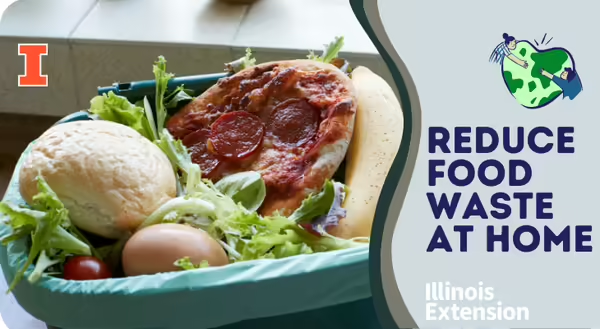
Food is a valuable resource and it’s often the center of our celebrations and life events so why do we let so much go to waste? The average person tosses about one pound of food per day. Small amounts of food waste may go unnoticed over time but households account for 38% of all food waste, which is more than grocery stores, restaurants, or any other sector!
The true cost of food waste is hidden so each time you throw food away at home or at a restaurant, you are also wasting the energy, resources, water and labor that was used to grow, process, and transport that food to your plate.
For example, the amount of water wasted when food is thrown away can be measured in shower minutes. A pound of bananas that ends up in the trash is equivalent to a 42-minute shower. A pound of ground beef, on the other hand, is equivalent to a shower lasting over six hours!
Reducing food waste is a shared responsibility and we can all play a part in reaching the national food waste reduction goal – to reduce food waste by 50% by the year 2030. Changing a few habits in our meal planning, preparation and storage can help reduce food waste at home, save money, and protect the environment.
Planning Tips
- Habits take time to build, including checking your kitchen food inventory before going shopping. Shop your refrigerator, freezer, and pantry first to avoid unwanted waste. Make a shopping list based on your weekly meal plan to avoid impulse buys.
- Notice how much food gets discarded during holidays and life events. Serve less food, try a no-food event, or send leftovers home with guests.
- Restaurants serve large portions that could easily be shared or taken home for another meal. Avoid waste when ordering food by sharing meals, asking for to-go containers, or selecting items from the lunch and à la carte menus.
Preparation Tips
- Make meal prep work for you. Portion out just enough to eat, and freeze the rest in portion containers for quick weeknight meals another day.
- Love your leftovers. Resist the urge to make something new for dinner if you already have food to eat from a previous meal. Think of “leftovers” as “ingredients” and repurpose them in new dishes like adding leftover veggies to a breakfast scramble.
- Use the fresh ingredients first. Nearly half of all fruits and vegetables go to waste so make it a point to use these items quickly before they end up in the trash. Keep food out of the landfill with these creative uses for food scraps (PDF).
Storage Tips
- Push the pause button on your food by freezing it. Freezing food flat cuts down on defrosting time and prevents large ice crystals from forming. Follow these Easy Steps to Freezing Foods (PDF).
- Organize food by the “use-by” or “best if used by” dates. Move older foods that are closer to their date in front. This way you are more likely to use them first.
- Keep fruits and vegetables fresh longer by using proper storage techniques. Store your ethylene-sensitive produce (greens, garlic, peppers, strawberries) separate from ethylene-producing items (apples, figs, tomatoes, grapes) whether in the fridge or on the counter. Try these storage tips for extending shelf-life of fruits and vegetables (PDF).
The confusing amount of date labels on our food packages can also lead to unintended waste. Check out this date label guide to learn more about which labels indicate quality rather than safety issues. Stilltasty.com is another source for “eating past the date” guidance.
April is Earth Month and a great time to take a closer look at the food waste generated at home. Take this Food Waste Challenge developed by the Environmental Protection Agency to find out how much is really going to waste in your home and what you can do to waste less. Creating a zero-waste kitchen can save you $1,500 or more each year!
Take this poll and tell us how you intend to rescue food- https://poll.fm/9957627
Written by: Kristin Bogdonas is the nutrition and wellness educator serving Henry, Mercer, Rock Island and Stark Counties.
Sources:
- Save Food for a Better Climate. Food and Agriculture Organization of the United Nations. 2017. Accessed March 18, 2021 from http://www.fao.org/3/i8000e/i8000e.pdf
- www.epa.gov/recycle/reducing-wasted-food-home
- www.savethefood.com
- www.refed.com